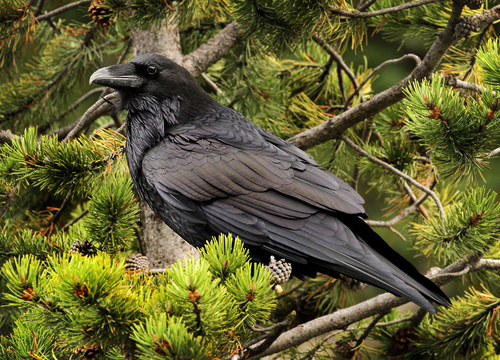
Common Raven
The Common Raven (Corvus corax) is a large, all-black passerine bird found across the Northern Hemisphere. Renowned for its intelligence, the raven plays a significant role in the mythology and folklore of many cultures, often associated with both wisdom and trickery. Ecologically, it is a highly adaptable species, occupying diverse habitats and exhibiting a wide range of behaviors. It's an opportunistic omnivore, contributing to ecosystem health through scavenging and seed dispersal.
56-78 cm
Length
115-150 cm
Wingspan
Least Concern
Conservation Status
Distribution
Found across North America, Europe, Asia, and North Africa. Ranges from Arctic tundra to deserts and mountainous regions. Generally non-migratory, though some populations may move short distances in response to food availability.
Lifespan
Up to 13 years in the wild; over 40 years in captivity.
Common Raven's Habitat
Habitat Types
Tundra, Forests, Grasslands, Coastal cliffs, Deserts, Mountains, Urban areas
Climate Zones
Arctic, Temperate, Subtropical, Tropical
Adaptations
Highly adaptable to varied climates and food sources. Feathers provide excellent insulation in cold environments. Strong beaks and feet allow for manipulation of diverse food items.
Variations
Several subspecies are recognized, differing slightly in size and bill shape based on geographic location. For example, *Corvus corax principalis* in northern North America is larger than *Corvus corax sinuatus* in the southwestern United States and Mexico.
Appearance
Breeding Plumage
Plumage is generally glossy black year-round.
Seasonal Feather Changes
No significant seasonal variation, though feathers may appear duller when worn.
Sex Based Plumage Differences
No significant visual difference between sexes.
Notable Features
Large, heavy bill, Shaggy throat feathers (hackles), Long, wedge-shaped tail, Strong legs and feet
Diet and Feeding
Primary Foods
Carrion, Insects, Small mammals, Birds' eggs and nestlings, Fruits, Grains, Human refuse
Foraging Behavior
Highly opportunistic; forages on the ground, in trees, or along shorelines. Known to cache food for later retrieval, displaying remarkable spatial memory.
Specializations
Strong bill allows for tearing flesh and manipulating objects. Highly adaptable to different food sources.
Seasonal Diet Variations
Diet shifts based on food availability. May rely more on carrion in winter, insects in spring, and fruits in autumn.
Behavior
Social Structure
Often seen in pairs or family groups. Young birds may form flocks. Highly social and exhibit complex social interactions.
Communication
Wide range of vocalizations, including croaks, gurgles, and rattles, Body postures, such as bill pointing and feather fluffing, Facial expressions
Migration
Generally non-migratory, but some populations may undertake short-distance movements in response to severe weather or food shortages.
Territorial or Group Behaviors
Pairs defend territories during breeding season. Non-breeding birds may form communal roosts, especially in winter.
Conservation
Threats
Habitat loss, Persecution (historically considered a pest), Lead poisoning (from scavenging on carcasses shot with lead ammunition), Collisions with vehicles and power lines
Protection Programs
Migratory Bird Treaty Act (in the US), Various state and provincial wildlife regulations
Local National Laws
Protected under various national and international laws.
Population Trend
Increasing
Population Estimates
Global population estimated at 16 million.
Interesting Facts
Ravens are among the most intelligent birds.
They are capable of problem-solving, tool use, and complex social interactions.
They can mimic sounds, including human speech.
Similar to parrots, ravens can learn to imitate words and other sounds.
Ravens have been observed playing games.
They have been seen sliding down snowbanks and engaging in aerial acrobatics seemingly for fun.
Ravens can recognize individual human faces.
Studies have shown they can remember and react differently to people who have previously threatened them.
They form long-term pair bonds.
Ravens are known to mate for life, maintaining strong bonds with their partners.
Faqs about Common Raven
What is the difference between a raven and a crow?
Ravens are larger than crows, with a heavier bill, shaggy throat feathers, and a wedge-shaped tail. Their calls are also deeper and more resonant.
Are ravens dangerous to humans?
Ravens are not typically aggressive towards humans, but they may defend their nests if they feel threatened. It's best to observe them from a respectful distance.
Do ravens eat garbage?
Yes, ravens are opportunistic omnivores and will scavenge on a wide variety of food sources, including human refuse.
Why are ravens often associated with death and bad omens?
Their black plumage, scavenging habits, and frequent presence on battlefields have contributed to their association with death in many cultures. However, they are also seen as symbols of wisdom and intelligence.
Can ravens be kept as pets?
In most places, it is illegal to keep ravens as pets without proper permits. They are wild animals with complex needs and are best left in their natural environment. Consult a wildlife expert for advice.
Copyright @ Nature Style Limited. All Rights Reserved.
 English
English